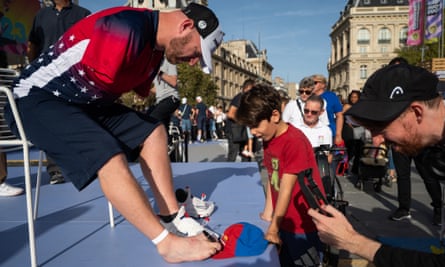How ‘armless archer’ Matt Stutzman transformed a Paralympic sport
Matt Stutzman believes that controlling adrenaline is crucial if you want to be a successful archer. So he made a quick parachute jump before training. “I would literally shoot my bow, get on a plane and jump out,” he says. “Then I would land nearby, shoot my bow until the adrenaline wore off and then go back up and jump out again.”
This may not be the kind of training approach that works for every athlete, but Stutzman deviates a bit from the norm. For starters, the American from Iowa is a world archery champion and recreational parachutist, born without arms. He’s also someone who, since childhood, has single-mindedly pursued what he calls a “Michael Jordan moment,” the point where one person changes not just his sport, but the perception of it. And when the Paralympic Games take place in Paris in a year’s time, it seems likely that he will have achieved his ambition.
Stutzman is known as the “Armless Archer,” and not just because of the alliteration. When he first competed in early 2010, he became the first person to attempt to shoot an arrow at a target without using fingers, wrist or triceps. His technique involves picking up an arrow and loading it with his toes, using a release mechanism on his shoulder to connect his body to his bow, and then leaning back in his chair to shoot. Using this technique, Stutzman hit a target from 300 yards in 2015, setting a world record for the longest accurate shot made in archery, regardless of whether it was made by someone with a disability or not.
The release mechanism is the only part of Stutzman’s equipment that has been adapted to his disability. This is the way he likes it and the way he has always been since childhood. “I told my dad I was going to be a basketball player,” he recalls. “He went and got me a basketball and a hoop and said, ‘here, go practice.’ He knew I would never be Michael Jordan, but I told him I was. That mentality…carried into everything I tried…and then I came across archery.”
Stutzman says he heard about the sport one night while watching TV and was spurred into action when he Googled “teaching a man with no arms to shoot a bow” and came up with nothing. “I remember going to an archery shop and telling someone I wanted to buy a bow,” Stutzman says with a chuckle. “The man said to me, ‘You need a crossbow because a crossbow is like a gun and easier to shoot.’ I said, ‘No, I want a compound bow.’ He said, ‘How are you going to shoot it?’ And I didn’t know, I just wanted one.”
Stutzman bought the bow anyway and was soon competing alongside non-disabled athletes using a technique he developed himself. He found a sponsor, and when a friend suggested the sponsor only paid him “because you don’t have arms,” Stutzman’s Jordan mode kicked into action. “That’s when it started,” he says. “Sitting in a chair for eight hours a day for the next eight years. That was all I did, practice and practice and practice.”
Within a year of focusing on his new passion, Stutzman won silver in the men’s individual compound event at the London Paralympics. For the next four years he was the world’s top-ranked paraarcher. After a period in the doldrums followed by the pandemic hiatus, Stutzman won his first individual World Para Archery title in February last year, scoring a perfect 30 in his final round. The scenes in Dubai were raw – “world champion baby!” was Stutzman’s refrain to the audience – but also emotional.

Stutzman won gold by beating Russian Aleksandr Gombozhapov. Gombozhapov is also an archer without arms. Just like the Belgian Piotr Van Montagu, who defeated Stutzman in the semi-finals. When he first picked up a bow during a competition, Stutzman was the only archer with his handicap. Just over a decade later, there are now others – men and women – who are not only following his example, but excelling.
after newsletter promotion
This is Stutzman’s Jordan moment: He created change. But an increase in armless archers speaks not only to the 40-year-old’s power as a role model, but also to the growth of parasports more broadly. So when it comes to Paris next year, Stutzman is clear about what he would like to see happen. “Winning is okay, it’s good right?” he says. “But do you know how good it would be to have one, two, and three armless archers? Because that really makes a statement about what the Paralympic Games are. We’re trying to grow the sport, we’re trying to grow the Paralympic Games as a whole and even if I was number four I would still feel like a gold medal because of what we’ve achieved.
Tickets for the Paralympic Games in Paris can be purchased at
